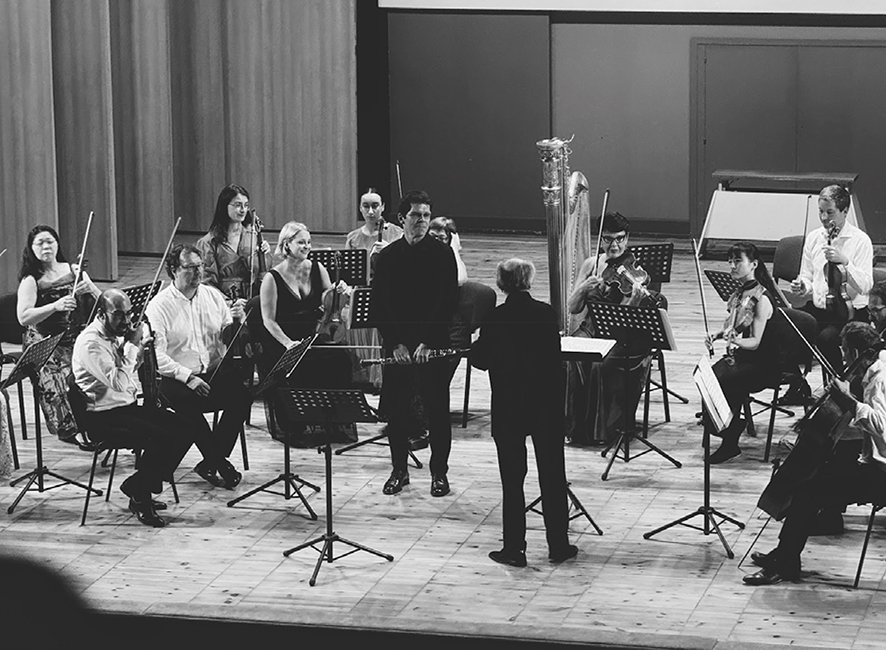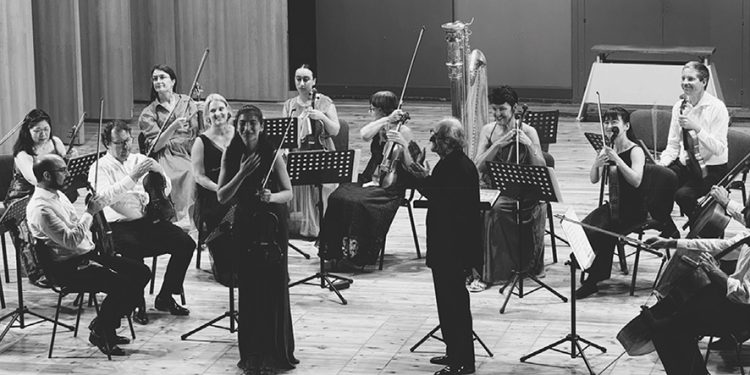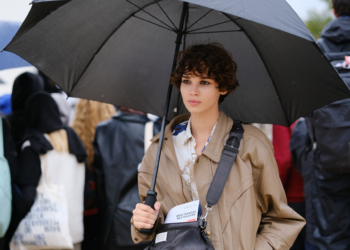On the evening of September 8, 2024, the Tbilisi Conservatoire Grand Hall became the site of a rare and significant musical occasion. The Austrian chamber orchestra “Arpeggione” made its debut in Georgia. The presence of Irakli Gogibedashvili, who has spent much of his career in Austria, added a layer of personal resonance to the event. It was, in a sense, a homecoming for the violinist, whose dual identity as a Georgian musician working abroad mirrored the thematic tensions of the evening’s program.
What stood out, however, was the understated nature of this concert. It was not a bombastic or overly celebratory affair, but rather a restrained and measured tribute. The orchestra’s repertoire for the evening, which included works by Mozart, Schoenberg, Rossini, Saint-Saëns / Ysaÿe, Pasculli, and Tchaikovsky, alongside Otar Taktakishvili’s compositions, was carefully curated. This selection seemed to signal an intention to bridge Georgian and European musical traditions without forcing the contrasts too starkly.
Otar Taktakishvili: A Centenary Reflection
Otar Taktakishvili remains a towering figure in Georgian music, his compositions deeply embedded in the national consciousness. The concert’s dedication to the 100th anniversary of his birth was a fitting opportunity to revisit his work, and to place it in a broader international context. Taktakishvili’s music, which blends traditional Georgian folk motifs with Western classical structures, holds a certain duality. It is as rooted in place as it is open to the influence of global trends in composition, particularly those of the mid-20th century.
The orchestra’s performance of Taktakishvili’s music highlighted these elements, but it did so with a sense of restraint. There was no over-exaggeration of the folk elements, nor an overemphasis on the European modernist aspects of his style. Instead, the musicians struck a balance, allowing the piece to speak for itself. In this, one sensed an awareness of Taktakishvili’s complex legacy—not only as a national composer but as a figure whose music continues to navigate the delicate relationship between tradition and innovation.
A Global Conversation
The remainder of the evening’s program provided an interesting counterpoint to Taktakishvili’s music. Beginning with Mozart, the concert opened on familiar, even canonical ground. The orchestra’s rendition of his work was precise, offering a faithful interpretation that showcased their technical ability without seeking to reinvent the material. This was followed by Schoenberg, whose distinct tonal challenges brought a modernist weight to the evening.
Schoenberg’s Violin Concerto, performed by Eliso Gogibedashvili alongside the Arpeggione Orchestra, was one of the most challenging pieces in the program, both technically and interpretively. The concerto is notoriously difficult for soloists, requiring not only immense technical precision but also an understanding of Schoenberg’s twelve-tone technique, which abandons traditional tonality. The complexity of the concerto lies in its angular lines, shifting textures, and seemingly dissonant passages, which can make it difficult for audiences to grasp on an emotional level.
Gogibedashvili’s performance was marked by its control and clarity, particularly in navigating the intricate passages that define Schoenberg’s style. Her playing was deliberate, avoiding the temptation to romanticize the music, instead allowing its intellectual rigor to come to the fore. The dialogue between the soloist and the orchestra, under the direction of Nurhan Arman, was handled with precision. Rather than forcing a narrative onto the music, the performers seemed content to let the piece speak for itself—a reflection of its austere modernism and Schoenberg’s break from traditional forms.

It was, without a doubt, a demanding performance for the audience as well. The violin concerto, with its lack of tonal resolution and fragmented structures, does not lend itself easily to casual listening. Yet, in the context of the evening’s program, it served as a reminder of the shifting boundaries of classical music in the 20th century, and the ways in which composers like Schoenberg challenged audiences to rethink their relationship to sound and structure.
Rossini’s contributions offered a lighter, more playful atmosphere, while the inclusion of Saint-Saëns and Ysaÿe introduced moments of virtuosity, particularly for the soloists, who were given ample opportunity to display their technical prowess. These works served as a reminder of the orchestra’s versatility, handling the nuances of each piece with careful attention to style and interpretation.
Pasculli’s oboe concerto, performed by Christoph Hartmann, stood out as a particularly challenging piece. Known for its technical demands, the piece requires extraordinary breath control and dexterity, both of which Hartmann demonstrated with relative ease. His performance was controlled and precise, but without overt displays of virtuosity that might detract from the integrity of the work itself.
The Interplay of Leadership
Conductor Nurhan Arman, who has an extensive international career, was likewise instrumental in guiding the orchestra through the evening’s contrasting pieces. His approach was subtle, opting for an interpretation that allowed the music to unfold naturally rather than imposing dramatic gestures. Arman’s direction was most effective in the transitional moments—between the classical precision of Mozart and the modernism of Schoenberg, and between the playful lightness of Rossini and the introspective qualities of Taktakishvili.
Violinist Eliso Gogibedashvili’s performance, was marked by its precision and clarity. Schoenberg’s and Ysaÿe’s compositions, known for their technical demands, require a performer to balance complexity with expressiveness, and Gogibedashvili managed this with understated elegance. There were no unnecessary flourishes or grand gestures—just a focused, disciplined performance that allowed the music to breathe.
Similarly, Christoph Hartmann’s oboe playing in Pasculli’s concerto was technically impeccable. His control over the instrument, particularly in navigating the rapid passages and extended phrases, was evident throughout. Yet, much like the rest of the evening, there was a sense of restraint—an avoidance of overt display in favor of a more thoughtful, measured interpretation.
Cultural Significance and Subtle Diplomacy
In many ways, the concert as a whole can be seen as an act of cultural diplomacy. Supported by the Ministry of Culture and Sport of Georgia, it brought a celebrated Austrian ensemble to a Georgian stage for the first time, creating a space for cross-cultural engagement. However, this engagement was not overtly stated or dramatized. Instead, it unfolded quietly, through the careful selection of works and the orchestra’s thoughtful interpretations.
The presence of Taktakishvili’s music alongside Western composers raised questions about the place of Georgian music within the broader European classical tradition. Yet, the concert did not provide definitive answers. Instead, it left space for reflection, allowing the audience to consider the ways in which Georgian music exists in dialogue with European traditions, without necessarily being subsumed by them.
As the final notes of Tchaikovsky’s serenade faded, the concert came to a close not with grand gestures, but with a quiet sense of resolution. There was an understanding, perhaps, that this evening was not meant to dazzle or overwhelm, but rather to reflect on the subtle interplay between tradition and modernity, between Georgia and the wider world.
By Ivan Nechaev














